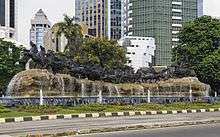Arjuna
| Arjuna | |
|---|---|
|
Arjuna statue in Bali, Indonesia | |
| Information | |
| Parent(s) |
Indra |
Arjuna (in Devanagari: अर्जुन arjuna) along with Krishna is the protagonist of the ancient Indian epic Mahabharata and plays a key role in the Bhagavad Gita alongside Krishna. Arjuna was the son of Indra, the king of the celestials, born of Kunti, the first wife of King Pandu in the Kuru Kingdom. In a previous birth he was a saint named Nara who was the lifelong companion of another saint Narayana an incarnation of Lord Vishnu who took rebirth as Lord Krishna. He was the third of the Pandava brothers and was married to Draupadi, Ulupi, Chitrangada and Subhadra (Krishna's sister) at different times. His children included Srutakarma, Iravan, Babruvahana, and Abhimanyu.
Etymology and other names
The name Arjuna has among its meanings "white"/"clear" and "silver".[1] Cognates of "Arjuna" are Latin "regens" meaning "ruler", Hindi "raj" meaning "king", and English "regal".
The Mahabharata refers to Arjuna by twelve different names. In the story, these names are given when Prince Uttara of Matsya asks Arjuna to prove his identity. The first ten names are spoken by Arjuna himself, while the name "Kapi Dhwaja" is also used to refer to his chariot, the "Nandi Ghosha". The names and their meanings are as follows:[2][3][4]
- Arjuna (अर्जुन) – shining or famous like silver
- Phalguna (फाल्गुन) – one born under the star named 'Uttara Phalguni'
- Jishnu (जिष्णु) – triumphant
- Kiritin (किरीटिन्) – one who wears the celestial diadem, Kiriti, presented by Indra
- Shwetavahana (श्वेतवाहन) – one with white horses drawing his chariot
- Bibhatsu (बीभत्सु) – one who created terror(bibhatsa) in war to his enemies[5]
- Vijaya (विजय) – always victorious in war
- Partha (पार्थ) – son of Pritha, another name for Kunti
- Savyasachin (सव्यसाचिन्) – ambidextrous
- Dhananjaya (धनञ्जय) – one who brings prosperity and wealth in the land he goes to
- Gudakesha (गुडाकेश) – someone who has thick hair[5]
- Kapidhwaja (कपिध्वज) – having the flag of Kapi (monkey) in his chariot (Arjuna's flag displayed an image of Hanuman from a previous encounter.)
- Parantapa (परन्तप) – one who concentrates the most, destroyer of enemies by his concentration
- Gandivadhanvan (गाण्डीवधन्वन्) – one who possessed the mighty bow named 'Gandiva' which was created by Lord Brahma
- Gandivadhara (गाण्डीवधर) – Gandiva holder
- Madhyapandava (मध्यपाण्डव) – the third of Pandavas, younger than Yudhishthira and Bhima and older than Nakula and Sahadeva
Birth and youth

After the death of Pandu (and Madri's subsequent sati), the Pandavas and their mother lived in Hastinapura, where they were brought up together with their cousins, the Kaurava brothers. Along with his brothers, Arjuna was trained in religion, science, administration and military arts by Bhishma.[6]
One day, when the princes were playing a game, they lost their ball in a well. When the rest of the children gave up the ball as being lost, Arjuna stayed behind trying to get it. A stranger came by and extracted the ball for him by making a chain of "sarkanda" (a wild grass). When an astonished Arjuna related the story to Bhishma, Bhishma realised that the stranger was none other than Drona. Bhishma asked Drona to become the Kuru princes' teacher. Seeking refuge from Panchala, Drona agreed.[7]
Tutelage under Drona
Under Drona's tutelage, the Kauravas and the Pandavas, along with the princes of Hastinapura's allies and vassals, learned weaponry. Arjuna became Drona's favorite and most accomplished pupil; specifically, he became a master in using the bow and the arrow. In a famous incident, Drona deemed that out of all his students, even his own son Ashwatthama, none but Arjuna had the steadfast focus to shoot the eye of a bird on a tree; he was proven right.[8]
Marriage to Draupadi
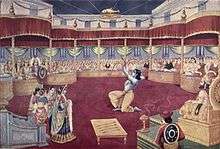
Still in hiding, the Pandavas disguise themselves as brahmins and attend the Swayamvara of Panchala princess Draupadi. Out of all of the great kings and other Kaurava princes, only Karna and Arjuna are able to do the established challenge. The test is to lift, string, and fire Pinakin to pierce the eye of a golden fish whilst only looking at its reflection; Drupada had designed this test with Arjuna in mind. At first Karna is able to lift and string the bow, but when he is aiming to fire the shot, Draupadi rejects Karna (in some depictions with Krishna's prodding) for his low-birth. Afterwards, the disguised Arjuna accomplished the stringing and shooting of the bow.
In some versions of the story, Arjuna is the only prince (of the Kaurava/Pandava party) to have interacted with Draupadi before. When attacking Drupada, Draupadi, trained in martial arts due to Panchal's attitudes towards gender neutrality, fights with Arjuna, but Arjuna after some while stops and evades Draupadi, saying that he cannot fight a woman.
In some versions of the Swayamvara, Arjuna is forbidden by Kunti to attend the Swayamvara. Kunti's reasoning is that only Yudhishthira and Duryodhana would be acceptable candidates for Draupadi's hand; anyone else, not set to inherit the throne, would be an insult to Panchal. She allows Bhima to attend because he is Yudhishthira's heir and could win Draupadi for his brother without controversy. When Arjuna disobeys her anyway, as he is firing the arrow, he swears to God that if he wins Draupadi's hand, he would never disobey his mother's commands.
When the brothers returned with Draupadi, Arjuna joked to his mother that they had brought alms. Dismissively, and without looking because she was preoccupied, Kunti asks him to share it with his brothers. Holding his mother's orders as a divine command, he requested his elder brother to accept Draupadi. Draupadi had to marry all five of the Pandavas. Her five sons, one from each of the Pandava brothers, are known as the Upapandavas. Srutakarma is the son of Arjuna.
The brothers follow Vyasa's advice on a sharing arrangement with regard to Draupadi: each brother would have exclusive rights over her for a year, after which the mantle would shift to the next brother. Moreover, any brother intruding on the privacy of the couple would have to go on a twelve-year Tirtha-yatra.
At this point in the Mahabharata, the Pandavas revealed that they were alive. With both Duryodhana and Yudhishthira being crown princes, tensions are high. Under Bhishma's advice, the kingdom is split, with the Kauravas getting Hastinapur and the Pandavas getting Khandavaprastha. Khandavaprastha, however, was an extremely underdeveloped land and had infertile soil, requiring extensive tilling, so the Pandavas set to work rebuilding the land. Their cousins Krishna and Balarama gave them aid.
Burning of Khandava Vana
In some versions of the story, this was the first time Arjuna meets Krishna. In any case, Khandavaprastha was where Arjuna and Krishna's friendship is truly forged. Once when roaming in the Khandava Vana, Arjuna and Krishna met the god of fire, Agni. Agni was in great hunger and needed to burn down the entire Khandava Vana to quench his hunger. But Takshaka, the serpent-king lived in the same forest and was a friend of Indra's. So the latter brought down heavy rains to thwart Agni's plans to burn the woods. Agni requested Krishna and Arjuna to help him realise his goal.[9]
The three of them then invoked Varuna, the God of the oceans, who blessed Arjuna with the Gandiva – the agni-moon bow created by Brahma. In this way, Arjuna came into possession of his famous bow. Agni also gave Arjuna an incandescent chariot with four horses yoked, and bearing a flag that would one-day be occupied by Hanuman. Arjuna also obtained his famous conch.
With Krishna using the Sudarshana Chakra[10] Arjuna and Krishna waged a successful battle against Indra and helped Agni burn down the entire Khandava Vana including all its demons and evil spirits. Indra's pride in Arjuna's success overcame his anger, and he bestowed greater powers on him.
Saving Mayasura

In their demolition of Khandava, Krishna and Arjuna had saved one demon, Mayasura.[9] Thus owing Arjuna a favor, and after being so directed by Krishna, Mayasura said that he would build a palace for Yudhishtra. As Mayasura was a great architect of the Asuras, he soon constructed the Maya assembly hall – a gigantic palace for the Pandavas, filled with ancient books, artifacts, and jewels. This hall was famous for visual illusions. Thus, Khandavaprastha was renamed Indraprastha.[11]
Arjuna's Tirtha-yatra and Indraprastha

During an incident when Takshaka stole Brahmins cows, Arjuna was forced to violate Yudhishthira and Draupadi's privacy while they were playing the game of dice, as he had left the Gandiva in their room. Despite the understanding of all and being forgiven by both Yudhishthira and Draupadi, Arjuna accepted the punishment agreed with Narada and set off on a twelve-year tirtha-yatra.
Meeting Ulupi
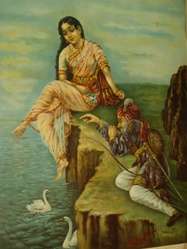
Arjuna started his pilgrimage by visiting the source of the river Ganga. It was here that he met the Naga princess, Uloopi. She was mesmerised by Arjuna and forcefully took him to Naga Lok (the land of the snake-people) and gave him a choice: if he married her, she would let him go; otherwise, she would not. He married her, and they had a son called Iravan.[12][13]
Chitrangadaa at Manipura
Arjuna visited other Tirthas in India, including Kalinga and the ashrams of the Saptarishis, Agastya, Vasishta and Bhrigu. Finally he reached the palace of Manipur. Here he met King Chitravahana's daughter, Chitrangadaa. Arjuna fell in love with her and requested that the king let them marry. Upon discovering Arjuna's true identity, the king readily agreed. Since Chitrangadaa was his oldest child and Manipur practiced equal primogeniture, which Hastinapur did not practice, the king sought a promise from Arjuna that Chitrangadaa and any of her and Arjuna's children would remain in Manipur as Chitravahana's heirs. Arjuna thought for some while and agreed. They had a son, who survived the Mahabharata war and ruled the small kingdom peacefully.[14]
Reaching Dwarka and Subhadra
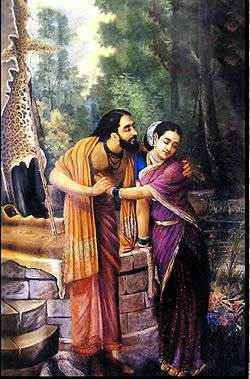
Painting by Raja Ravi Varma.
Arjuna moved to other Tirthas, including the southern regions in Kerala. Finally he reached Dwarka, the place where his cousin Krishna resided. Arjuna had, in his childhood, heard about Krishna's sister, Subhadra. Krishna, wishing to further tie their families, knew of Arjuna's visit and devised a plan to arrange their meeting. Accordingly, Arjuna disguised himself as a Yati and stayed at Krishna's palace. Arjuna fell in love with Subhadra and desired to marry her. Because Balarama had already promised Subhadra to his favorite disciple, Duryodhana, Krishna advised Arjuna to kidnap Subhadra. Balarama became furious upon learning of the abduction but was pacified by Krishna, after he showed that the Mangala sutra was in Subhadra's hand, which showed her consent. The couple stayed in Dwaraka for a year, and then another year in Pushkar. However, Draupadi had made it clear that no other Pandava wife would be allowed to stay in her city, so Arjuna, as Krishna had advised, tricked Draupadi into meeting Subhadra as a milkmaid. Draupadi realized she had been tricked, but she forgave Subhadra and let her stay in Indraprastha, allowing her to keep company with Arjuna in the four years when he was not with Draupadi. In due course, the union of Arjuna and Subhadra produced a son, Abhimanyu.[15][16]
Conquest for Rajasuya


Arjuna was sent north by Yudhishthira to subjugate kingdoms for the Rajasuya Yagya, so that he could be crowned Emperor of Indraprastha. The Mahabharata mentions several kingdoms to the east of Indraprastha which were conquered (or otherwise peacefully bent-the-knee) by Arjuna.[17] Most notably, he defeats Bhagadatta of Pragjyotisha who repelled Arjuna for eight days straight but impressed with Arjuna's skill agreed to pay tribute. Bhagadatta was also a great friend of Pandu.
Exile
After Yudhishthira succumbed to Shakuni's challenge in the game of dice, the Pandavas were forced to be in exile for 13 years, which included one year in anonymity.
Penance for Pashupatastra
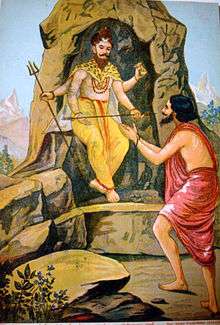
After the battle at Khandava Indra had promised Arjuna to give him all his weapons as a boon for matching him in battle with the requirement that Shiva is pleased with him. Sensing an impending war with the Kauravas, Sage Vyasa advised Arjuna that he obtain the Pashupatastra from Lord Shiva. Following the advice of Sage Vyasa to go on a meditation or "tapasya" to attain this divine weapon, Arjuna left his brothers for a penance.
Arjuna traveled for a while before reaching the mountain Indra keeladri, Vijayawada. Here he sat in meditation in the name of Lord Shiva. Shiva appeared soon enough in the guise of a hunter, who challenged Arjuna to a fight. While being thoroughly dominated by Shiva, Arjuna became confused as to how an ordinary hunter could beat a warrior like himself. He prays to Shiva for strength, and then sees the offerings he made to Shiva around the hunter's neck. Shiva was very pleased with the bravery and prowess of the prince. Consequently, Shiva transformed himself to show his real avatar and blessed Arjuna with the Pashupatastra. Shiva lectures Arjuna on the abilities of the weapon, as well as the judgement he must use while wielding it.
After Shiva left, the Lokapalas appeared before Arjuna and then Kubera, Yama, and Varuna also blessed each of their potent weapons to Arjuna. Indra then invited his son to his palace in heaven.
Arjuna was amazed at the splendor of his father's palace at Amaravati. Dancers like Urvashi, Tilottama, Rambha and Menaka entertained him. There was a huge banquet serving different varieties of heavenly dishes. Arjuna learnt song and dance from the Gandharva, Chitrasena and Indra himself taught him all the divine weapons and also gave him his Vajra.[18]
Urvashi's curse
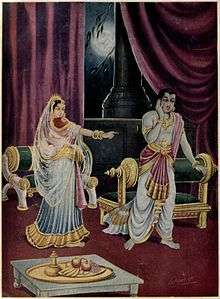
Indra noted the passionate glances exchanged between Arjuna and Urvashi during his stay. However, Arjuna refused her advances, alleging that he had heard of her relationship with his ancestor Pururava, and hence she had the status of a mother, equal in respect to Kunti. Urvashi, annoyed at this, cursed him so that he would become a eunuch who would have to live among women, singing and dancing. On Indra's request, and regretting her anger, Urvashi reduced her curse to a period of one year of Arjuna's choice. In some versions of the story, Urvashi curses Arjuna with womanhood, but always reduces the curse to a year's length.
Nivata-kavachas and Hiranyapura
Arjuna got the opportunity to test his skill when Indra asked him to defeat his enemy as the price of his training. Arjuna was taken to the palace of the Nivata-kavachas, a tribe of Rakshasas who had a magnificent palace under the oceans. Arjuna used the Mohini-astra and the Madhava-astra to demolish these asuras.
He was also taken to Hiranyapura, a palace in the sky created by a witch Puloma and his asura tribe of the Kalakanjas. Here Arjuna uses the Raudra-astra and annihilates the demons.[19]
Meeting Hanuman
Continuing his quest, Arjuna visits the site of Rama Setu in Dhanushkodi. There, he openly questions why, if Rama had been such a great archer, he hadn't simply built the bridge out of arrows. Angered at Arjuna's tone and his apparent questioning of Rama's prowess, Hanuman confronts Arjuna in the form of an ordinary monkey and challenges him to prove his superiority by building a bridge of arrows that could bear his (Hanuman's) weight. Tensions escalate until Arjuna pledges to defeat Hanuman or kill himself, going so far as to frivolously use divine weapons to build bridge after bridge, while Hanuman uses his god-given strength to destroy them all. Eventually, Krishna intervenes, chiding Arjuna for his excessive pride and Hanuman for allowing his love of Rama to overcome his pacifism. Regaining his composure, Hanuman pledges to reside in Arjuna's battle standard (flag) during the Kurukshetra war.[20]
Eunuch at Virata's Kingdom
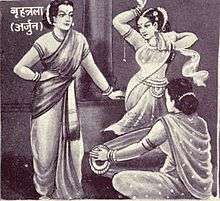
Along with his brothers, Arjuna spent his last year of exile in the kingdom of Matsya. This is the place where Urvashi's curse is implemented and Arjuna becomes a eunuch called Brihannala (within themselves Pandavas called him Vijaya).[21] At the palace, he teaches song and dance, qualities he had learnt from Chitrasena [King of the Gandharvas in Devalok], to the King Virata's daughter, Uttarā. Later, Arjuna arranges for Uttara to become his daughter-in-law by marrying his son Abhimanyu to her. At the same time, he prevents Subhadra from marrying Abhimanyu to Balarama's daughter Vatsala, as the Kurus find marriages between cousins taboo. But Arjuna and Subhadra are cousins too since Kunti (Arjun's Mother) and Vasudeva (Subhadra's father) are brother and sister.
Hearing about the death of Kichaka, Duryodhana surmises that the Pandavas were hiding in Matsya. A host of Kaurava warriors attack Virata, presumably to steal their cattle, but in reality, desiring to pierce the Pandavas' veil of anonymity. Full of bravado, Virata's son Uttar attempts to take on the army by himself while the rest of the Matsya army has been lured away to fight Susharma and the Trigartas. As suggested by Draupadi, Uttar takes Brihannala with him, as his charioteer. When he sees the Kaurava army, Uttar loses his nerve and attempts to flee. There, Arjuna reveals his identity and those of his brothers'. Switching places with Uttar, Arjuna takes up the Gandiva and Devadatta. Eager to defend the land that had given him refuge, Arjuna (dressed up as Brihannala) engaged the legion of Kaurava warriors, leading Matsya to victory and giving all credit for the victory to Uttar in his place.[22][23][24]
Kurukshetra War
Bhagavad Gita

As the battle draws close, Arjuna is overcome with self-doubt about the righteousness of the war against his own kith and kin. He is distraught at the thought of having to fight with his friends and family such as his dear teacher, Drona and grandsire Bhishma. It was then that Krishna took charge and explained the necessity and inevitability of the war to Arjuna. This conversation is a key part of the Mahabharata known as Bhagavad gita, and is considered as a holy scripture of Hinduism.
Arjuna plays the role of the reader in the Bhagavad Gita. As Krishna dispenses the advice, Arjuna asks the questions.
The Bhagavad Gita primarily takes the form of a philosophical dialogue between Arjuna and Krishna.
Battles fought at Kurukshetra

Arjuna was a key Pandava warrior and played a huge role in the Pandava victory in the Kurukshetra war. His flag bore the symbol of Hanuman.
Some of the crucial battles fought by Arjuna are as follows:
- Fall of Bhishma: Throughout the first nine days of battle, Arjuna was unable to defeat Bhishma. Arjuna was able to compel Bhishma to retreat on the 3rd day of the war, however, this was not a decisive victory for him. This was partially due to his own reluctance to fight his grandsire, as well as Bhishma's terrific skill. As Krishna became frustrated with Arjuna, he took up arms against Bhishma himself, at least twice. Not wanting history to blame Arjuna for forcing Krishna to break his vow of non-aggression, Arjuna managed to talk Krishna down and fought with renewed vigor. On the tenth day of the war, after asking Bhishma himself how to decisively defeat him, Arjuna took Shikhandi in his chariot. As Bhishma would not raise weapons against a woman, Arjuna was able to attack Bhishma unimpeded. Tears flowing from his eyes, Arjuna pierced Bhishma's entire body with arrows, eventually forcing Bhishma to fall down with Arjuna's arrows acting as a bed, thus breaking the rule of battle. As per Bhishma's request, he provided a pillow of arrows for his head, as well as water by piercing the earth and allowing Ganga to nourish her son. Bhishma praised Arjuna for this and asked Duryodhana to make peace with the Pandavas.[25]
- Death of Bhagadatta: On the 12th day of the war, Arjuna was busy fighting Bhagadatta, the king of Pragjyotisha, who had earlier defeated Bhima and Satyaki. During the battle, Bhagadatta shot an irresistible weapon called Vaishnavastra, which could have killed Arjuna, but he was saved by Krishna's timely intervention; Krishna stood up covering Arjuna, and the weapon fell on Krishna and formed a garland. Bhagadatta was later decapitated by Arjuna's arrow.
- Killing of the Trigartas: Attempting to distract him so that Drona could capture Yudhishthira, Susharma and the Trigartas challenged Arjuna to a fight to the death. On the 12th and 13th days of battle, Arjuna succeeded in killing most of them, however, he fought against remaining units of the Trigarta army on the 16th and 17th days as well, and finally on the 18th day of the war, Susharma was defeated and killed by Arjuna. And on the eighteenth day, Arjuna killed Susharma with an arrow which ended the Trigarta saga.
- Death of Jayadratha: Arjuna held Jayadratha responsible for Abhimanyu's death on the 13th day of the war. He vowed to kill him the very next day before sunset, failing which he would kill himself by jumping in a pyre. The Kauravas hid Jayadratha from Arjuna in a formation, knowing that Arjuna's death would result in a Kaurava victory. However, Krishna created an artificial eclipse by using his Sudarshana Chakra to hide the sun, forcing Kauravas to believe it was sunset and Arjuna's death was imminent. (In some versions, it is said that Lord Krishna used his yogic power to hide the sun). Overjoyed, they started celebrating, and using that opportunity, Arjuna caught them unprepared, reached near Jayadratha, and made his arrows to carry away Jayadratha's head. This was because Jayadratha had a boon from his father that whoever would be responsible for his head falling to the ground would have his own head blown up. That is why Arjuna carried the severed head of Jayadratha to his father, who was awoken from his meditation by the sudden landing of a severed head on his body and since he ended up dropping it to the ground, he had his head blown up.[26]

- Death of Karna:Karna was a nearly equivalent archer to Arjuna in Mahabharata. On the 17th day of the war, the final combat between Arjuna and Karna took place, with Karna slowly gaining the upper hand. The warriors on the battlefield and the gods in heaven watched the battle in speechless amazement and terrified admiration of the strength and skill of these two greatest of warriors. At one point, Karna used Nagastra in an attempt to kill Arjuna, but Krishna saved Arjuna from certain death by lowering the chariot wheel into the earth, which made the arrow only take off Arjuna's crown. Karna and Arjuna then again waged a rough war against each other. The battle was continuing equally, but then Karna's chariot wheel got stuck in the mud resulting from a prior curse on Karna from Bhudevi. Further, owing to a curse Karna received from his Guru Parashurama, Karna forgot the mantra to invoke the Brahmastra. Karna got down from his chariot to free the wheel and asked Arjuna to pause, reminding him of the etiquette of war. But Krishna reminded Arjuna of all the incidents suffered by the Pandavas, Draupadi’s insult and Abhimanyu’s death; and the enraged Arjuna attacked Karna while he was trying to lift his sunken chariot wheel.
Karna retaliated even though he was on the ground, and even succeeded in knocking Arjuna unconscious for a few moments. He tried to use the opportunity to free the chariot-wheel, however, Arjuna regained consciousness, and prompted by Krishna, killed the unarmed, afoot Karna with the Anjalika weapon.
Some interpretations claim that it is actually Krishna who killed Karna, using Arjuna as his vessel, thereby freeing Arjuna of the shame of blatantly violating the rules of war.
Arjuna's Chariot burns after war
After the eighteenth day of war at Kurukshetra, King Duryodhana was slain in a mace fight with Bhima by unfair means. Soon after Duryodhana's fall, the Pandavas went to celebrate their victory by entering the palaces of the Kauravas. When they reached the pavilion of the Kauravas, Lord Krishna advised Arjuna to take his divine bow Gandiva and get down from his chariot immediately. After Arjuna did so, Lord Hanuman disappeared from his flag and Lord Krishna also got down from the chariot. Soon after Lord Krishna releases the horses and then gets down from the chariot. The chariot explodes into pieces. That was due to the devastating effect of the astras such Brahmastras which were used by Karna and Drona and other warriors in the battle. Arjuna wondered at seeing such a horrible scene and asked Krishna about the reason. Lord Krishna said that the divine chariot of Arjuna had already been burnt by consuming diverse kinds of weapons, including the Brahmastras , that they had shot against Arjuna during the fighting. It was because of his power that the divine chariot of Arjuna remained un-burnt throughout the battle. [27] [28]
Conquest for Ashvamedha
After the conclusion of the war, the Pandavas take charge of Hastinapura, the undivided realm of their ancestors. Yudhishira appointed Arjuna as the Yuvaraj of Hastinapura.[29]
Yudhishthira decided to hold the Ashvamedha Yagna, or "horse sacrifice", to grant them the title of Chakravarti ("Emperor"). Arjuna led the armed forces which followed the horse around its random wanderings. He received the submission of many kings, either without or following an armed confrontation. He was thus instrumental in the expansion of the Pandava domains.
Arjuna built the Aranmula Parthasarathy Temple during his conquest in South India. Aranmula Parthasarathy Temple is one of the "Divya Desams", the 108 temples of Vishnu revered by the 12 poet saints, or Alwars[30] located near Aranmula, a village in Pathanamthitta District, Kerala, South India. The temple is dedicated to Parthasarathy, Lord Krishna's role as Arjuna's Charioteer in the Mahabharata war.[31] Legend has it that Arjuna built this temple, to expiate for the sin of having killed Karna on the battlefield, against the dharma of killing an unarmed enemy.
Manipur and death by Babruvahana

Arjuna went to Manipur, where the king was Babruvahana, his own son with Chitrangadaa. Seeing his father Babruvahana came all the way to receive Arjuna. Arjuna was very upset that Babruvahana did not respect the duties worthy of a King and did not ask for war. He cursed his son as a coward and asked him to prepare for war. In the fight between father and son Babruvahana killed Arjuna, but Ulupi, the snake-princess, used the Mritasanjivani, a boon from Ganga Devi to bring Arjuna back to life. It is later stated that the defeat was because of Arjuna's using of Shikhandi to plot Bhishma's death and the unethical killing of Karna.[32]
Death

After Sri Krishna left his mortal body, Arjuna took the citizens of Dwaraka, including 16,000 women that had formed Krishna's harem, to Indraprastha. On the way, they were attacked by a group of bandits. Arjuna fought with them but he had already lost his divine energy and even lost the power to wield the celestial bow Gandiva. Arjuna forgot all his celestial weapons and soon his inexhaustible quiver became empty due to the disappearance of divine energy owing to the death of Krishna.[33][34]
Upon the onset of the Kali yuga and acting on the advice of Vyasa, Arjuna and other Pandavas retired, leaving the throne to their only descendant to survive the war of Kurukshetra, Arjuna's grandson Parikshit. Giving up all their belongings and ties, the Pandavas, accompanied by a dog, made their final journey of pilgrimage to the Himalayas. It is also to be noted that the listener of the Mahabharata is Janamejaya, Parikshit's son.[35]
Except for Yudhishthira, all of the Pandavas grew weak and died before reaching heaven (only Yudhishthira is allowed to keep his mortal body). Arjuna was the fourth one to fall after Draupadi, Sahadeva and Nakula. When Bhima asks Yudhishthira why Arjuna isn't permitted the same, the reason given is Arjuna's extreme pride in his skills as an archer. Draupadi also falls because while she claimed to love all the Pandavas equally, she had a soft spot for Arjuna .[36]
In popular culture
Arjuna is a popular choice of name for a Hindu male child in the Indian subcontinent. As told in the verses in Harivamsha or Harivamsha Purana, the name Arjuna is cursed by the sage Parashurama. After the defeat of the mighty and evil king Kartavirya Arjuna or otherwise called Sahasra Arjuna, Sage Parashurama pronounced the curse that whoever holds the name Arjuna will never become a king and always be a servant of others.[37]
Modern references
Arjuna's extraordinary talents and skills have made him a common name in popular culture.
- The American astronomer Tom Gehrels named a class of asteroids with low inclination, low eccentricity and earth-like orbital period as Arjuna asteroids.[38][39][40]
- The Arjuna Award is presented every year in India to one talented sportsman in every national sport.
- Arjun is a third generation main battle tank developed for the Indian Army.
- Mayilpeeli Thookkam is a ritual art of dance performed in the temples of Kerala. It is also known as Arjuna Nrithyam (lit. Arjuna's dance) as a tribute to his dancing abilities.
There have been a serial and a film based on Arjuna's life and exploits.
- Earth Maiden Arjuna is a Japanese animated television series created by Shoji Kawamori. This series is based on Arjuna and the Mahabharata. Arjuna: Into the Another World is the soundtrack produced for the series.
- Arjun: The Warrior Prince is a 2012 mythological action film narrating the events in Arjuna's life.
- "Arjuna" is a character in Orson Scott Card's "Earth Afire" and "Earth Awakens" made in 2013 and 2014 respectively.
Additionally, the protagonist in Steven Pressfield's book The Legend of Bagger Vance, Rannulph Junuh, is based in part on Arjuna (R. Junuh).[41]
Arjuna is also an Archer class Servant in the mobile game Fate/Grand Order. He is a minor antagonist in the E Pluribus Unum story chapter, where he wishes to fight Karna again.
In Modern Television
In B.R.Chopra's Mahabharat, Arjuna's role is played by Arjun (Firoz Khan).
In 2013 Mahabharat Television series, Arjuna is portrayed by Shaheer Sheikh.
Mani Ratnam's 1991 blockbuster Thalapathi was loosely based on the Mahabharata. In the film, Arvind Swamy's character was loosely based on Arjuna
In Dharmakshetra 2014, Actor Ankit Arora Portrayed Arjuna
In 2015 Sony TV serial Suryaputra Karn, Actor Navi bhangu played the role of Arjuna
In Nagarjuna 2015 serial, Rahul Sharma (actor) played Arjuna
Notes
- ↑ Monier-Williams, Monier (1899). A Sanskrit-English dictionary : etymologically and philologically arranged with special reference to cognate Indo-European languages. Oxford: Clarendon Press.
- ↑ Fowler, Jeaneane Fowler, Merv. Bhagavad Gita : a text & commentary for students. Brighton: Sussex Academic. p. 10. ISBN 9781845193461.
- ↑ Kapoor, Subodh, ed. (2002). The Indian encyclopaedia : biographical, historical, religious, administrative, ethnological, commercial and scientific (1st ed.). New Delhi: Cosmo Publications. p. 1927. ISBN 9788177552577.
- ↑ Sarma, Bharadvaja (2008). Vyasa's Mahabharatam in eighteen parvas : the great epic of India in summary translation. Kolkata, India: Academic Publishers. p. 372. ISBN 9788189781682.
- 1 2 "Different names of Arjuna in Mahabharata". www.speakingtree.in. Retrieved 2017-01-06.
- ↑ Johnson, W. J (2009). "A Dictionary of Hinduism". Oxford Reference. Oxford: Oxford University Press. doi:10.1093/acref/9780198610250.001.0001. (Subscription required (help)). (subscription or UK public library membership required)
- ↑ Leeming, W. J (2009). "The Oxford Companion to World Mythology". Oxford Reference. Oxford: Oxford University Press. doi:10.1093/acref/9780195156690.001.0001. (Subscription required (help)). (subscription or UK public library membership required)
- ↑ Parmeshwaranand, Swami (2001). Encyclopaedic dictionary of Purāṇas (1st ed.). New Delhi: Sarup & Sons. pp. 512–513. ISBN 9788176252263.
- 1 2 Mahabharata of Krishna-Dwaipayana Vyasa. Teddington, Middlesex: The Echo Library. 2008. pp. 518–520. ISBN 9781406870459.
- ↑ Menon, [translated by] Ramesh (2006). The Mahabharata : a modern rendering. New York: iUniverse, Inc. pp. 302–304. ISBN 9780595401871.
- ↑ Verma, retold by Virendra; Verma, Shanti (1989). The Mahābhārata : (the great epic of ancient India). New Delhi: Pitambar Pub. Co. p. 28. ISBN 9788120907324.
- ↑ The Mahabharata, Book 1 of 18: Adi Uloopi gave her husband a boon which allowed him to be invincible in water. She was on extremely good terms with her co-wife, Chitrangada, and very fond of her stepson Bhabruvahan, son of Chitrangada and Arjun. She later restored Arjun to life when he was defeated and killed by the Manipur prince.Parva. Forgotten Books. pp. 513–515. ISBN 9781605066110.
- ↑ "Mahabharata Text".
- ↑ "Mahabharata Text".
- ↑ "Mahabharata Text".
- ↑ "Mahabharata Text".
- ↑ "Mahabharata Text".
- ↑ "The Mahabharata, Book 3: Vana Parva: Indralokagamana Parva: Section XLIV". Retrieved 3 August 2016.
- ↑ "The Mahabharata, Book 3: Vana Parva: Tirtha-yatra Parva: Section CLXXII". Retrieved 3 August 2016.
- ↑ "Hanuman and Arjuna".
- ↑ Kapoor, edited by Subodh (2002). The Indian encyclopaedia : biographical, historical, religious, administrative, ethnological, commercial and scientific (1st ed.). New Delhi: Cosmo Publications. p. 4462. ISBN 9788177552577.
- ↑ Arvind Sharma (1991). Essays on the Mahābhārata. Brill.
- ↑ Wendy Doniger O’Flaherty. Karma and Rebirth in Classical Indian Traditions. Berkeley University of California Press.
- ↑ K M Ganguly(1883–1896)The Mahabharat Book 3: Virata Parva Section LXV aryabharati.org, October 2004, Retrieved 2015-12-23
- ↑ Ganguly, Kisari. "The Mahabharata of Krishna-Dwaipayana Vyasa".
- ↑ Kisori Mohan Ganguly translation of Mahabharat P-321 Drona Parv, Chapter 146
- ↑ Shalya Parva chapter 62 Arjuna's chariot burns
- ↑ Shalya Parva chapter 61 Arjuna's chariot burns, BORI sanskrit version mahabharat
- ↑ "Mahabharata Text".
- ↑ 108 Vaishnavite Divya Desams: Divya desams in Malai Nadu and Vada Nadu. M. S. Ramesh, Tirumalai-Tirupati Devasthanam.
- ↑ David Abram; Nick Edwards (2004). The Rough Guide to South India. Rough Guides. p. 348. ISBN 1843531038.
- ↑ "Mahabharata Text".
- ↑ "Death of Krishna and Aftermaths".
- ↑ "Defeat of Arjuna".
- ↑ Bowker, John (2000). "The Concise Oxford Dictionary of World Religions". Oxford Reference. Oxford: Oxford University Press. doi:10.1093/acref/9780192800947.001.0001. (Subscription required (help)). (subscription or UK public library membership required)
- ↑ "The Mahabharata, Book 17: Mahaprasthanika Parva: Section 2". sacred-texts.com. Retrieved 23 March 2015.
- ↑ Ramachandrashastri, K.S (1936). Harivamsha. Pune: Chitrashala Press.
- ↑ S. Lewis, John (1996). Rain of iron and ice: the very real threat of comet and asteroid bombardment. Addison-Wesley Pub. Co. pp. 82–83.
- ↑ Lee, Ricky J. Law and regulation of commercial mining of minerals in outer space. Dordrecht: Springer. ISBN 9789400720398.
- ↑ de la Fuente Marcos, C.; de la Fuente Marcos, R. (12 February 2015). "Geometric characterization of the Arjuna orbital domain". Astronomische Nachrichten. 336 (1): 5–22. Bibcode:2015AN....336....5D. arXiv:1410.4104
 . doi:10.1002/asna.201412133.
. doi:10.1002/asna.201412133. - ↑ Gita on the Green: The Mystical Tradition Behind Bagger Vance – Steven Rosen – Google Boeken. Books.google.com. 2002-05-30. ISBN 9780826413659. Retrieved 2013-08-09.
